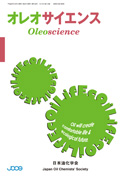All issues

Volume 5, Issue 6
Displaying 1-3 of 3 articles from this issue
- |<
- <
- 1
- >
- >|
-
Design of Hydrogen-bonded Supramolecular Materials by Hierarchical Control of Structural DimensionsKoji ARAKI, Jun LI, Isao YOSHIKAWA2005Volume 5Issue 6 Pages 265-272
Published: June 01, 2005
Released on J-STAGE: June 01, 2013
JOURNAL FREE ACCESSAppropriately designed low-molecular-weight organic compounds can form self-assembled nano-to mesoscopic-scale supramolecular polymers having a variety of structures by non-covalent intermolecular interactions. To fabricate macro-scale supramolecular materials, the supramolecular polymers have to be assembled further into macro-scale ordered structures. For this purpose, we adopted the molecular design to use non-polar and soft segments as molecular-level cushions in order to assist the assembling process and also applied external mechanical forces in order to induce macro-scale ordering of the supramolecular polymers. Based on this strategy, the supramolecular fibers,, gels, and films were successfully fabricated hierarchically. Molecular design to cover the hydrogen-bonded linear chains by the soft segments and use of the melt-or heat-spinning process allowed fabrication of the flexible supramolecular fibers, in which the one-dimensional hydrogen-bonded polymer chains were aligned along the fiber axis. Two-dimensional hydrogen-bond networks were formed by additional hydrogen-bonds between the linear hydrogen-bonded polymer chains, and molecular design to sandwich this networks by soft segments led to formation of two-dimensional sheet-like structures which induced organogelation by trapping the solvent molecules in between the sheets. Self-supporting and flexible supramolecular films were also fabricated by introduction of polar groups at the surface of the sheet-like structures. These results demonstrate that the molecular design to use soft segments is the efficient method to fabricate supramolecular materials.View full abstractDownload PDF (2146K) -
Masaki KOGISO2005Volume 5Issue 6 Pages 273-279
Published: June 01, 2005
Released on J-STAGE: June 01, 2013
JOURNAL FREE ACCESSIn nanotechnology, one-dimensional nanostructures are one of the important targets to construct nanodevices. In nature, functional biological molecules such as peptides, sugars, nucleic acids, and lipids grow up to macromolecular biological structures by non-covalent bonds such as hydrogen bond, hydrophobic interaction, electrostatic interaction, and so on. Peptides can form interesting secondary structures represented by α-helix and β-sheet using amide-amide hydrogen-bond networks. Some peptide lipids were known to form 1-D nanomaterials with solid surface such as nanotubes and nanofibers due to hydrogen-bond networks between the peptides. We provided here the formation of 1-D non-covalently-bonded macromolecules from peptide bolaamphiphiles. Bolaamphiphiles have an advantage of more stable nanostructures formation in comparison with usual amphiphiles. Oligoglycine bolaamphiphiles self-assembled in water to form lipid microtubes or nanotubes via polyglycine II-type 2-D hydrogen-bond networks. In contrast, valylvaline bolaamphiphiles produced nanofibers due to β-sheet-type 1-D hydrogen-bond networks. COOH groups on the surface of the nanofibers can also provide a scaffold for 1-D organization of transition-metal cations. The reduction of these metal cations on the surface of the nanofibers gave 1-D organized copper nanoparticlesView full abstractDownload PDF (2358K) -
Norihiro YAMADA, Takeshi HASEGAWA2005Volume 5Issue 6 Pages 281-288
Published: June 01, 2005
Released on J-STAGE: June 01, 2013
JOURNAL FREE ACCESSMultiple H-bonding has been observed as a β-sheet structure in the cast films of the peptide-containing amphiphiles. These amphiphiles produce a self-supporting transparent film, but they are extremely brittle. This result means that another interaction, which immobilizes the β-sheets, will be needed for improving the mechanical strength of the supramolecular film. Thus, we attempted to use the side chains of the peptide part. Because the side chains of the adjacent amino acid residues locate in opposite directions across the β-sheet plane, the side chains could interlock with counterparts of the other β-sheet planes. This specific interdigitated structure should fasten the β-sheet planes when the peptide part contains at least three consecutive leucine. We prefer to use this action leucine fastener. The leucine fastener will never be formed if a β-sheet structure is absent. Emphasis is placed on this hierarchy. In our case, monomeric units self-assembled into a supramolecule formed a β-sheet assemblage. The β-sheet assemblages were integrated by the leucine fastener, and finally produced a supramolecular polymer. We demonstrated here the hierarchic integration of supramolecular monomers, and described the formation of a self-supporting elastic film, in which repeating units were linked by non-covalent bonds.View full abstractDownload PDF (3091K)
- |<
- <
- 1
- >
- >|